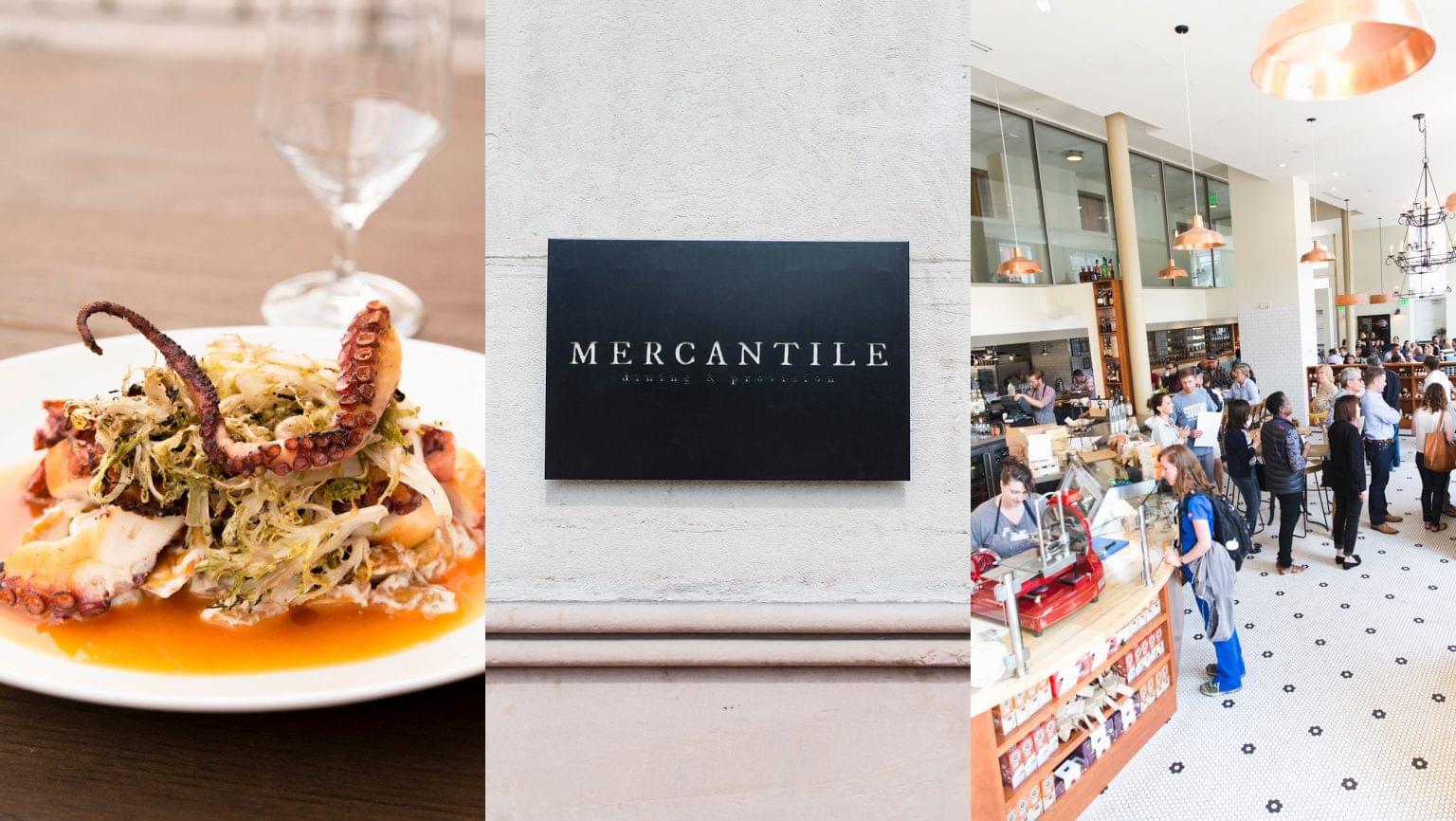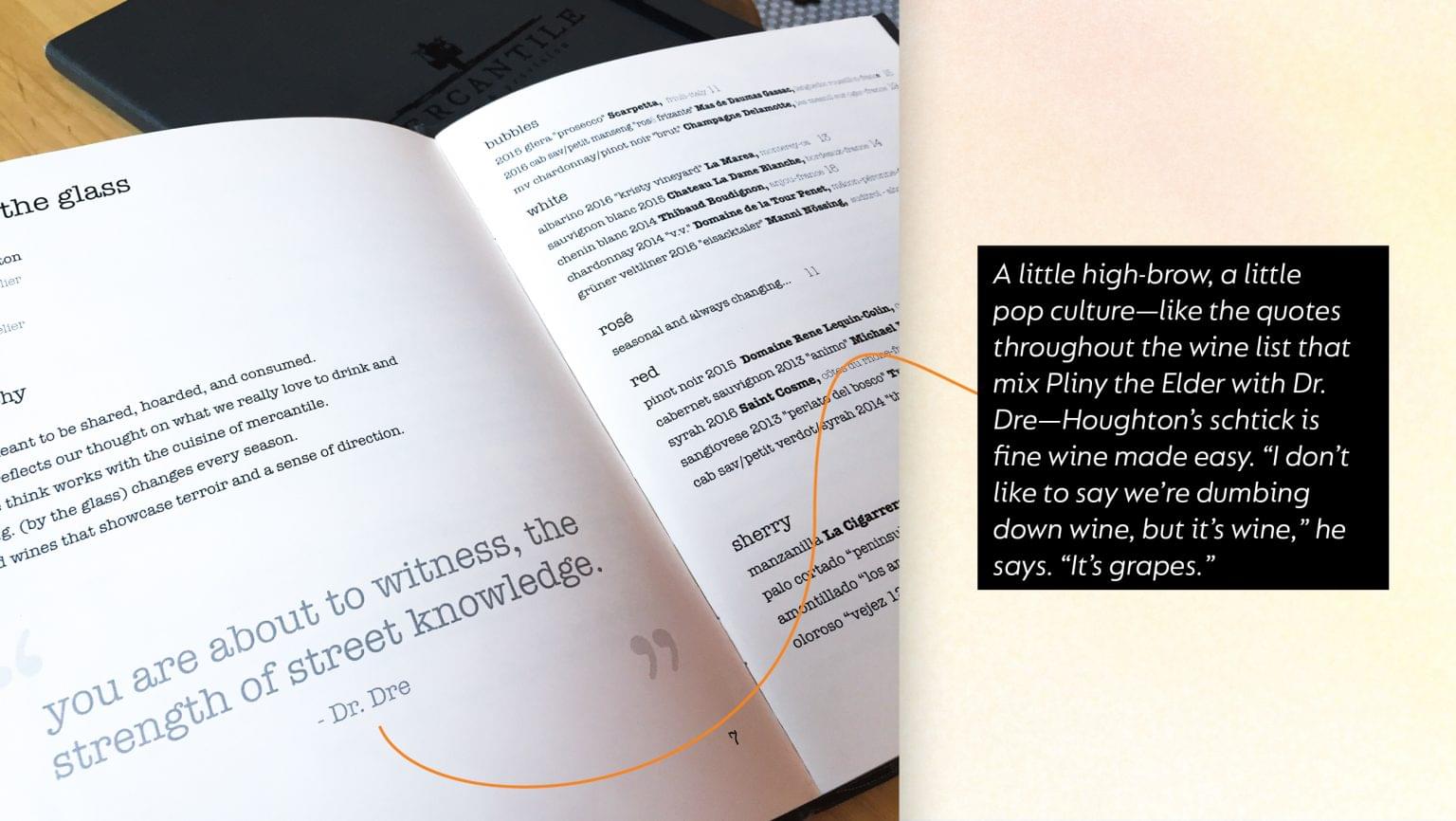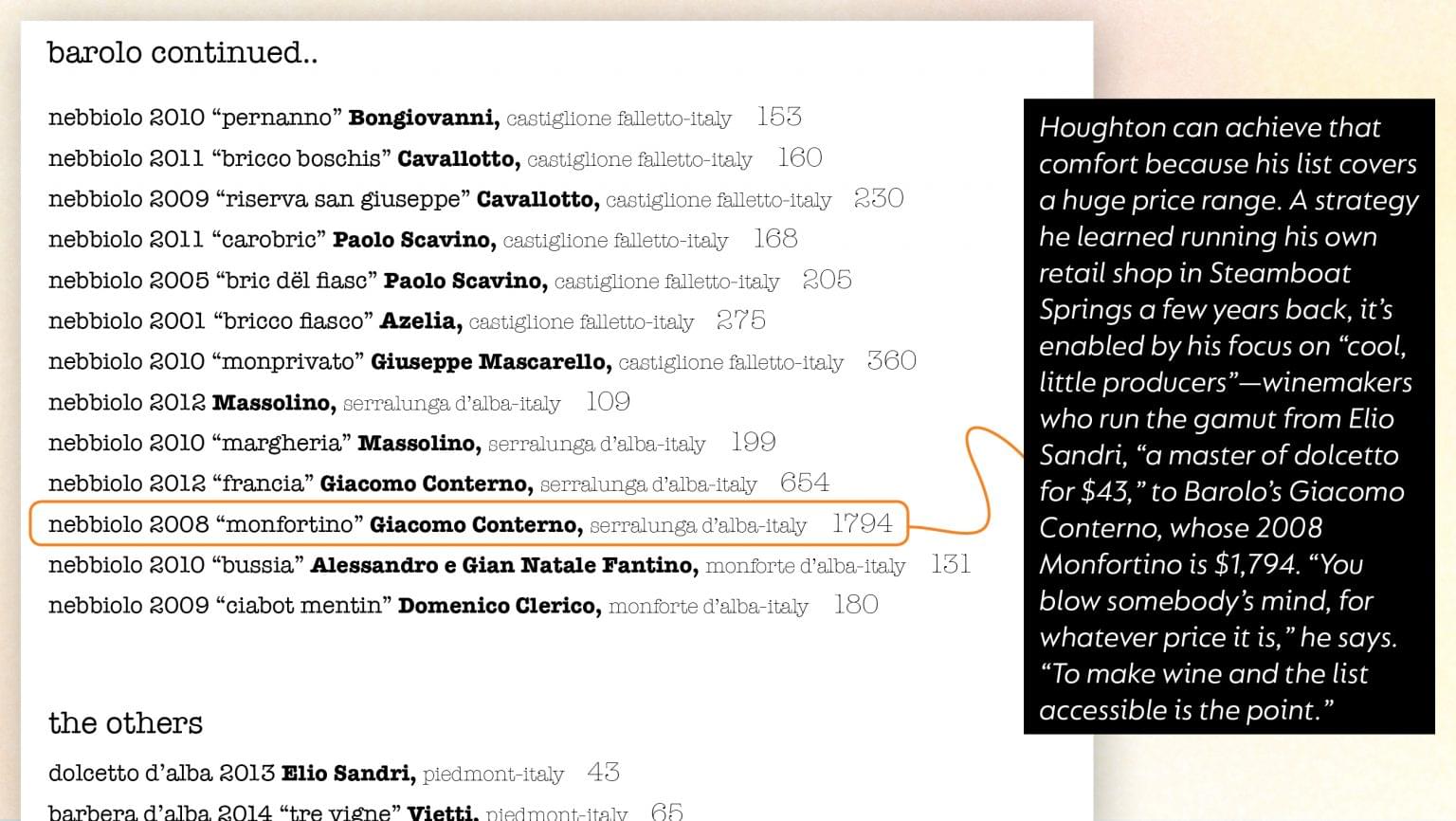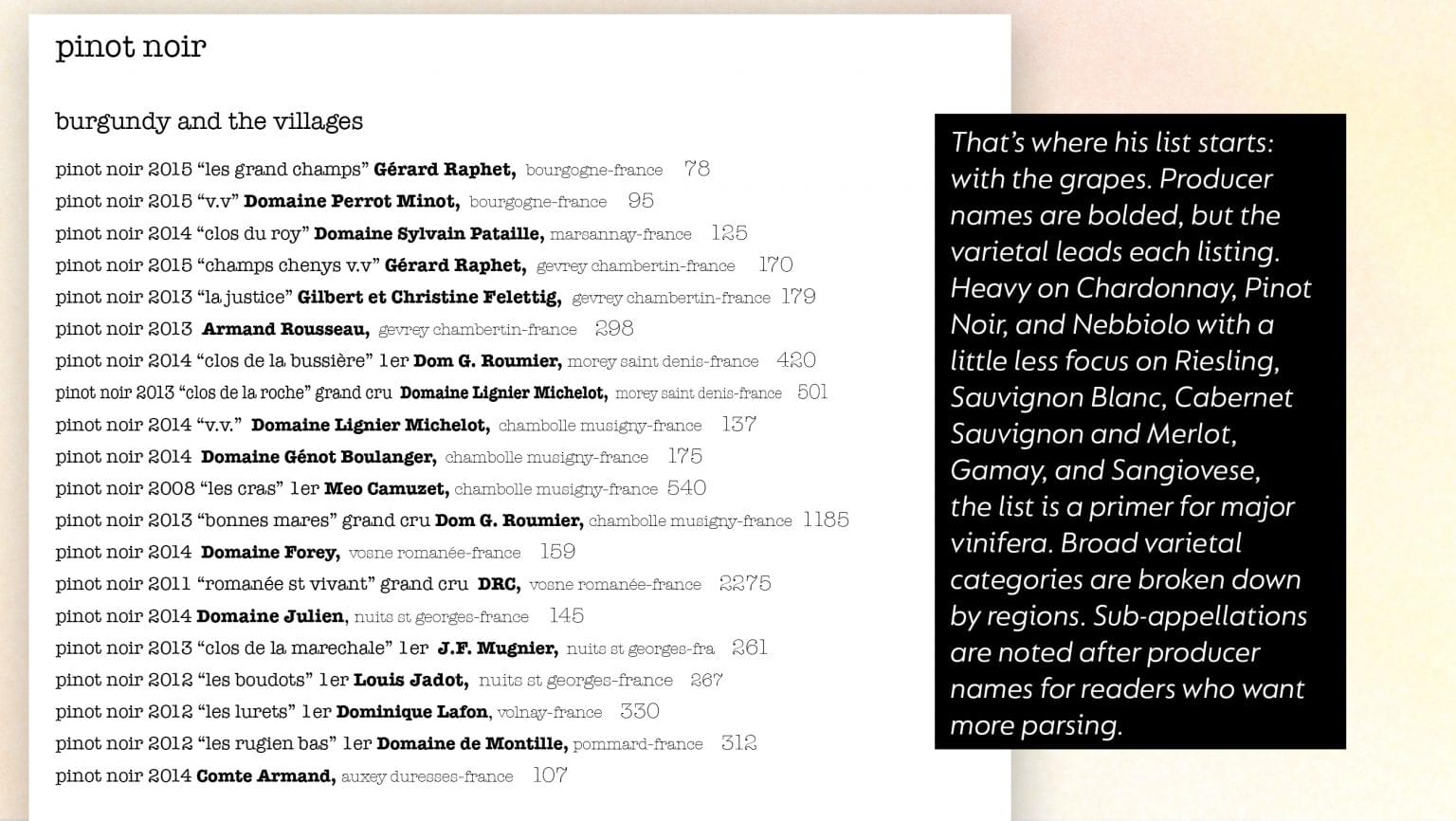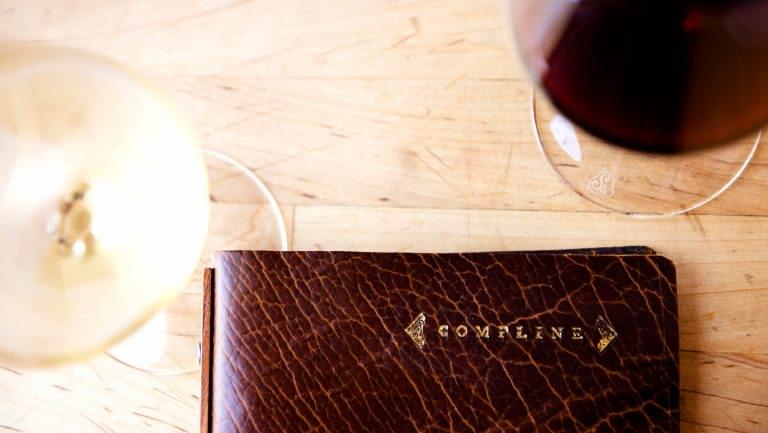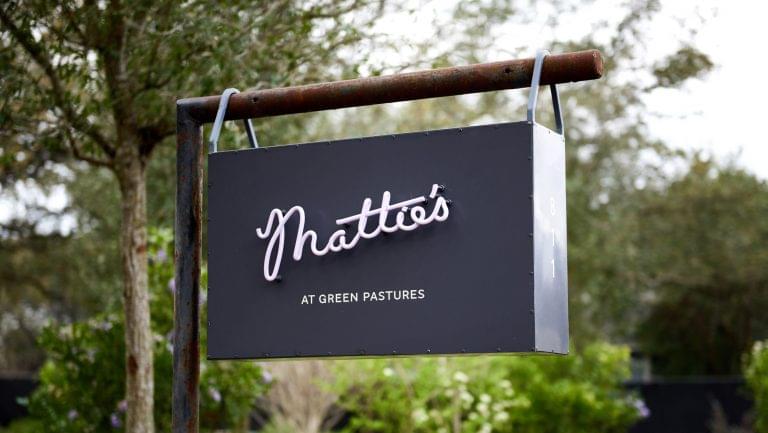It was late on an autumn afternoon at Mercantile Dining & Provision, farmer and chef Alex Seidel’s restaurant and market in a sun-drenched corner of Denver’s Union Station neighborhood and Patrick Houghton, Mercantile’s wine director, had just finished with the weekly blind-tasting group he hosts. “I got three for four today,” he said, shrugging. “It’s fun to nail wines and know what they are, but it’s fun to get your ass kicked and be humbled by the wines, too, to make you work harder.”
Composed of staff from Mercantile and other restaurants (including Seidel’s flagship, Fruition, where Houghton also manages the list), all of whom are studying for sommelier exams, the group is part of Houghton’s efforts “to start a little wine revolution in Denver.” An Advanced CMS himself, Houghton, who is 40, is reinvigorating Denver’s scene with a program that while elevated is down to earth—it’s producer driven but accessible to every diner. For the farm-to-table anchor of a city commuter hub, it’s just the right approach.
With an outdoor café, a locavore grocery, and all-day dining, the three-year-old Mercantile is a restaurant built for a contemporary commute, one in which shopping, eating, and drinking are as important as getting where you’re going. The Victorian station that houses it has been transformed into a playground for a city that Forbes calls a mecca for millennials. Mercantile’s wine list fits right in. It’s a seasonally changing artisan collection created by a garrulous fellow who likes to use the word “fun” to describe what he’s doing.

Don’t miss the latest drinks industry news and insights. Sign up for our award-winning newsletters and get insider intel, resources, and trends delivered to your inbox every week.
“I think we take ‘pretentious’ out of wine,” says Houghton. That’s a ballsy statement, given a 300-bottle list peppered with names like DRC and Poggio del Sotto. But cult Burgundys and Tuscans notwithstanding, Houghton has an everyman’s attitude toward the hands-on producers he favors. “I just think that these winemakers are people like us, but they chose wine,” he says. “So as long as it’s good, man, let’s drink it.”
He pours a 2014 Anjou Blanc from the Loire Valley’s Thibaud Boudignon. At $18 a glass, it’s expensive for the West. But it comes from a rising star who makes naturally fermented wines from just 3.8 hectares of organic old vines. It’s a find for Mercantile diners, and the way Houghton describes it makes this Chenin Blanc eminently approachable. “Boudignon reeks of fall,” he says. “It’s got a touch of barrel, so it works with the butternut squash soup with foie mousse. It brings out the richness. I also think of Chenin Blanc as sweet and sour, so it pushes that dish a little. I think of restaurants I used to go to with my father when I was little: Chinese food. Sweet and sour. That’s Chenin. The barrel gives it texture, but the acid still rips. Boudignon’s wines are pretty special. It’s higher priced. But he’s doing it pretty well.”
There’s a lot going on in that description: seasonality, varietal characteristics, winemaking methods, winemaker accomplishments, pairing notes, price. Houghton conveys all of it, along with a nostalgic anecdote and a flavor descriptor that’s widely relatable. A little highbrow, a little pop culture—like the quotes throughout the wine list that mix Pliny the Elder with Dr. Dre—Houghton’s schtick is fine wine made easy. “I don’t like to say we’re dumbing down wine, but it’s wine,” he says. “It’s grapes.”
That’s where his list starts—with the grapes. Producer names are boldfaced, but the varietal leads each listing. Heavy on Chardonnay, Pinot Noir, and Nebbiolo, with a little less focus on Riesling, Sauvignon Blanc, Cabernet Sauvignon and Merlot, Gamay, and Sangiovese, the list is a primer for major vinifera. Broad varietal categories are broken down by regions. Sub-appellations are noted after producer names for readers who want more parsing. Though Houghton stocks New World producers “that have a sense of place and direction,” the list favors the Old World, whose subtleties mesh with Seidel’s classically influenced New American fare. The list’s organization enables quick lessons—about the kinship between Burgundy, for instance, and the American Pinots that might be more familiar.
“I came from teachers,” says Houghton, the son of educators who got his start in his family’s restaurant on Cape Cod. “I’m a teacher, but I teach wine to the youth.” Two sommeliers work under him, but he encourages waiters to sell bottles, too. It’s part of his mission to make the wine accessible.
“When they say, ‘Oh, this list is so intense,’” Houghton says, “I say, ‘You don’t know how to sell Burgundy? Well, that’s Pinot Noir. You can talk about Pinot Noir from Oregon, California, and Burgundy because you know Pinot Noir.’” Houghton leads servers through blind tastings using the Court of Master Sommeliers tasting grid every day before service. “We’re fortunate to open bottles for the staff,” he says. Seidel allows him that flexibility.
It’s the same flexibility shown with diners. “We’re not a no restaurant by any means,” Houghton says. “If someone doesn’t like the wine, I will open something else, and that conversation will happen ASAP. That’s our job.”
In fact, conversation is more important to Houghton than a written list. “Even myself,” he says, “I’d rather just say, ‘This is what I like to drink. Dealer’s choice me and bring me back something that hopefully I’ll dig.’ We have a list for people to look at. But most of the time, we just talk about what you’re feeling like drinking.”
That’s true even with the tasting menus at the chef’s counter, where the wine pairings are bespoke. “Do you like all whites?” says Houghton. “Off-dry? Red wines? It’s wherever people want to go.”
Though the quest for interesting producers drives his list, “nobody gives a shit about the producer,” he says, “if they’re coming in and saying, ‘Hey, I don’t really know much about wine.’” It’s only after diners have approved of what he’s poured that he talks about where it came from. He starts the discussion in a friendlier place, with flavor profile and, crucially, price. Says Houghton, “I want people to feel comfortable.”
Houghton can achieve that comfort because his list covers a huge price range. A strategy he learned running his own retail shop in Steamboat Springs, Colorado, a few years back, it’s enabled by his focus on “cool, little producers”—winemakers who run the gamut from Elio Sandri, “a master of dolcetto for $43,” to Barolo’s Giacomo Conterno, whose 2008 Monfortino is $1,794. “You blow somebody’s mind, for whatever price it is,” he says. “To make wine and the list accessible is the point.”
His markup is the standard two and a half to three times his cost, but with a wide spread and outsider producers, he can offer bargains like Luigi Giordano’s “little mother jammer” of a Nebbiolo-Arneis blend, which “works with anything on the menu,” for $48. “I love selling inexpensive stuff,” says Houghton. It’s part of his championing of producers.
He keeps an eye out, too, for steals from higher-priced winemakers. Mercantile usually gets multiple cases of “killer fucking Chablis” from “super-rad dude” Thomas Pico, for instance, but because Pico’s vineyard was decimated by hail this year, the restaurant got only six bottles, plus a preorder for the next premier cru release and a case of the Vin de Pays Chardonnay that Pico made to stay afloat. “We have to support these guys,” says Houghton. “I know it’s not his fruit, but he’s still making his wine with his soul, so we’ll pay for a wine that we won’t get for six months.” In the meantime, his diners can nab a Thomas Pico bottle for only $55.
Finding such opportunities takes legwork. Houghton buys from as many as 15 distributors, but he favors companies, like Synergy Fine Wines, that focus on small-case production. And his buys start with his own insights. “I’m researching producers all the time,” he says. He prints a new wine list every three months, but he’s designing it in his head half a year out. Storage space for about 1,000 bottles helps. “You’ll have this fall direct import offering for Italy, Germany, and Champagne. And in the spring, more Bordeaux,” he says. “I know it’s coming in. I know it’s gonna be gone. So I’ll buy it.”
He often works with limited allocations, but even if he gets just a bottle or two, the wine goes on his list. When he sells it out, he stamps a little image of red scissors over the bottle price. The exception is his rosé inventory, which turns over too fast to merit being typed up. So Houghton’s come up with a creative, bargain solution: “We pick out a bunch of crazy rosés at all different price points,” he says, “and we sell them for $44. That’s always changing, our roller-coaster rosé. For $44 you could be drinking a $68 Sancerre rosé that was last year’s vintage, but they couldn’t sell it all, so we bought it and it’s killer.”
Elevated wine sense, down-to-earth salesmanship—that’s Houghton in a nutshell. The approach is reflected in the glass list, which assistant sommelier Abbie Minton is creating as part of her training. Three sparklings, five whites, five reds, and four sherries—it’s a diverse collection with an educational bent. Browne Family Tribute from Walla Walla, Washington, and Olga Raffault Les Picasses 2010, from the Loire Valley, were both on the fall reds list. “Abbie wanted to pour Cab Franc,’” explains Houghton. “So we have two representations of Cabernet: a big New World wine with a Bordeaux varietal set, and a traditional Cab Franc where Cab came from, and we talk about that with people.”
He pours reds like that into a Schott Zwiesel Pure Bordeaux glass. Pinot, sparkling, and most whites go into Schott Zwiesel’s Pure Burgundy glass. At $5 or $6 a stem, the glassware is “sleek, fun, and affordable,” says Houghton, but the two basic shapes are true to the aromatics and alcohol content of the wines. And he might pour anything into a Reidel or Zalto decanter. “We’re at altitude,” he says. “Open it up. The air’s thinner. I’ll decant Champagne. I don’t care.”
At once professional and refreshingly casual, Houghton’s attitude toward wine is a large part of the success of Mercantile, whose wine sales top 20 percent of overall sales. And even in a town with a vibrant cocktail scene and an inordinate number of craft brewers, wine accounts for 80 percent of the restaurant’s beverage sales. Beer and cocktails are also important for Mercantile’s something-for-everyone vibe, and beverage director Nick Lowe, who oversees cocktails and spirits, and Ryan Rebhan, in charge of beer, share a focus on producers, seasonality, and—Houghton’s word—fun.
“We have three people who are very educated in their areas in the front of the house,” Houghton says, “but at the same time, we’re just hospitality people. We just want to have a good time. We want to party. We want to have some food, some drinks, some laughs—and we get to create our own little areas. It’s crazy how well received it’s been.”

Dispatch
Sign up for our award-winning newsletter
Don’t miss the latest drinks industry news and insights—delivered to your inbox every week.

